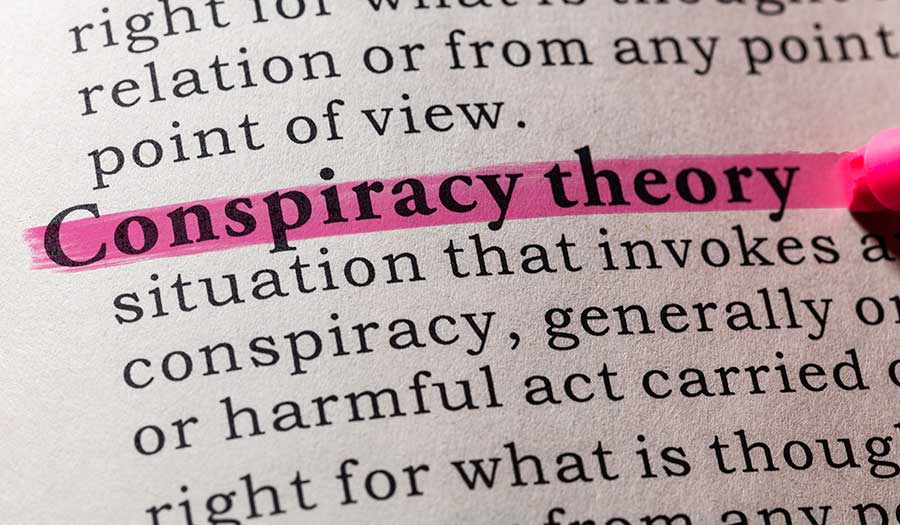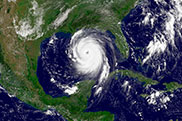 Getty Images
Getty Images
Article
Beliefs that covert governments and organizations are orchestrating world events are widespread. You can understand why such fringe ideas persist.
Learn the why behind the headlines.
Subscribe to the Real Truth for FREE news and analysis.
Subscribe NowThe moon landing of 1969? It was filmed on a Hollywood soundstage…That building down the road—the one with the manufacturing sign out front? It is actually a United Nations-run prison camp…You don’t really think that NASA has a Mars Lander, do you? That’s all done with computer-generated special effects…Did you know the most recent hurricane to hit the coast was engineered by government scientists?
To most, such statements are nothing more than bad jokes. But some people’s lives revolve around these ideas.
As technology continues to connect like minds in new and more efficient ways, conspiracy theories are spreading as never before. And they seem here to stay. But are they worth exploring?
Seeds of Distrust
Conspiracy theories have a long history—even in a nation as young as the United States.
“American pamphleteers in the 1790s warned of a plot by atheist, libertine Illuminati and Freemasons to concoct an abortion-inducing tea and ‘a method for filling a bedchamber with pestilential vapours.’ The bestselling book of the 1830s was a racy confession by a repentant nun detailing a scheme by Catholics to undermine Protestant morals. At around the same time, Samuel Morse, better known as the inventor of Morse Code, exposed an Austrian plan to install a Hapsburg prince as emperor of the United States” (The Economist).
Some of the most well-known theories involve the assassination of U.S. President John F. Kennedy in 1963. The lone-gunman theory endorsed by the investigating Warren Commission was received with widespread skepticism, which released a flood of conjecture that persists to this day. Other well-known theories include:
- The condensed water vapor left behind jet engines are chemtrails, or chemical agents sprayed into the air to purposely affect human beings.
- HIV and crack cocaine were both created by government agencies as genocidal weapons.
- The UN monitors Americans with black helicopters.
- Groups such as the Bilderbergers and Illuminati are re-engineering global systems into a New World Order.
- The 2004 Indian Ocean tsunami was caused by an Indian-Israeli-American nuclear test.
- Fluoridation of water is part of a plot to control the population’s behavior.
- The global Jewish community secretly controls most of the world, as set forth in the (fraudulent) Protocols of the Elders of Zion document.
- The U.S. military has the remains of extraterrestrials and their spacecraft stored at a southwest Air Force base.
A few other recent theories include that martial law was secretly passed through the American Senate, European officials planned the November 2015 terrorist attacks in Paris, the Ebola outbreak was a government plot, and the United States is directly assisting North Korea to develop its nuclear program.
Powerful “Drug”
The obsession with conspiracy theories has been compared to an addiction. Once a person has delved deeply into this mindset, recovery—a return to balanced, sound thinking—is rare.
What draws a person to these in the first place?
 Project Apollo Archive/NASA
Project Apollo Archive/NASAConspiracy theories are a powerful source of pride and intellectual vanity. The theorist comes to see himself as thinking on a higher plane than the ignorant masses around him. He walks the fringes of society, watching his surroundings with suspicion. No one realizes what’s going on, he thinks.
If speaking his mind on conspiracies causes others to recoil, he simply dismisses them as “dumb sheep” who cannot see what he sees. Every episode like this further reaffirms how special this inside information makes him.
While many conspiracy enthusiasts lack education, the supposed inside knowledge they gain makes them feel superior—one of the elite, enlightened few. “Besides, who needs schools? They’re just brainwashing centers run by ‘the machine,’ right?”
Many of these individuals enjoy the thrill of perceived danger that comes along with having supposedly top-secret knowledge, feeling as though they have a lead role in a secret-agent film—except they are not in a movie!
If anyone attempts to point out serious flaws in a theory’s logic, there is a standard response: The conspirators purposely do certain things that appear to counter their goals, just to keep investigators off the trail. Once this idea is accepted, any facts—whether or not they appear to fit the supposed covert scheme—reinforce the theorist’s central idea that “things are not as they seem.”
Fueled by Technology
This thinking has found a new outlet with the Internet. As of this writing, a Google search for “conspiracy theory” returns about 16 million results.
The Web has allowed countless new theories to surface—and ancient ones to resurface.
The idea that the Earth is a flat disk continues to draw interest, especially after a popular U.S. musician openly supported the theory. One flat-Earth argument is that the planet’s curvature is not visible from the ground. The idea is that high-altitude pictures of the globe’s curvature are falsified images intended to dupe people.
Imagine all who would have to be “in on it”: airplane pilots, astronomers and everyday passengers on flights would all have to lie about having witnessed the curve of the planet. On top of this, space agencies would have to craft false photographs to display a globe instead of a flat Earth.
 Thinkstock
ThinkstockWebsites and online forums (along with television shows) featuring conspiracy theories are multiplying.
One online forum devoted to this subject featured discussions on nearly 120,000 separate topics—and it is growing. These include: “Egyptian Statues on Mars?” “Dead Celebrities That Are Now Alive,” “Mermaid Caught Swimming,” and “Strange Snake Creature with Human Face and Blonde Hair Killed.”
Those who are drawn to this strain of thinking once relied on a scant selection of special-order books, a magazine subscription or two, and their own imaginations to fuel the obsession. Now, these “birds of a feather” can cross-pollinate ideas across the world via the Internet.
This results in a large online community of theorists who validate and feed one another’s delusions. Meanwhile, in the real world, the theorists become isolated from friends, family and co-workers who will not join them in a fantasy world.
One columnist wrote of this online community: “After all, thanks to Google we can find ‘evidence’ in support of practically any belief. If you can imagine the conspiracy theory, there is a website out there ardently promoting it, and a clan of fellow believers who share your peculiar obsession with fluoridated drinking water and the New World Order. The end result is that we never have to recant. We can always find another link to ‘prove’ that the government is trying to ‘zombify’ us, or that aliens are going to destroy the earth at midnight” (Wired).
Despising Government
A common thread of many theories is the idea that “the government” is responsible for terrible calamities, and is generally deceiving its citizens. For example, some believe the United States turned a blind eye to advance knowledge of the 9/11 attacks—or even directly perpetrated them—and now uses doctored videos and media manipulation as part of the cover-up.
This approach plays to an aspect of human nature that the apostle Peter wrote of nearly two millennia ago, describing those who “despise government” (II Pet. 2:10).
Increasingly, the average citizen has less respect for law or authority of any kind. Extreme examples are found in some conspiracy theorists who see themselves as above any and all law.
 Thinkstock
ThinkstockBut this reveals the hypocrisy of many conspiracy buffs. The majority of Western governments now provide more benefits and services for their citizens than any other time in history: medical coverage, food aid, unemployment benefits, welfare, defense, travel infrastructure, food and fuel subsidies, stimulus packages, and the list goes on. How many theorists refuse the generosity of the governments they rail against?
Can You Know?
Make no mistake: There are conspiracies on planet Earth. Anyone with basic knowledge of human nature understands that some groups are perfectly willing to commit covert crimes to gain advantage, power or wealth.
However, the idea of well-known international organizations, with widely varied and often conflicting interests, somehow working together behind the scenes over decades—always conspiring, but never quite achieving their secret goals—becomes silly when examined in the light of reason. This is perhaps most true with theories that involve groups such as the United Nations, which have bureaucracies that make meeting even their publicly stated goals difficult, never mind covert agendas.
Is there any way to know what is true?
There are ultimately three positions one can hold on these theories: First, they are all true—which is definitely not the case! Even if they were reality, there would be nothing you could do about them. Second, they are all false, and human beings never engage in attempts to deceive others. Third, they are a mixture of both, and there is no way to know which is which. If this last option is the case, then what is the point of delving into them?
 Thinkstock
ThinkstockOne terrible result of these ideas is that untold hours of human energy and attention, which theorists might otherwise have put toward productive and positive ends, vanish in a cloud of smoke.
But aside from wasted time, such theories can hold other dangers: “In extreme cases, conspiracy theories can cost lives,” The Economist reported. “Adolf Hitler sincerely believed he was ridding the world of a Jewish menace. Many Serbs were convinced that the Muslims of ex-Yugoslavia were out to annihilate them. And many Rwandan Hutus, informed by their leaders that the Tutsis were planning to kill them, were happy to follow orders to pre-empt this threat.”
The most unbalanced members of a society, when exposed to these ideas, can be driven to commit terrible acts, including assault and mass murder.
The Real Conspiracy
Despite most conspiracy theories being wild speculation and fiction, you may be surprised to learn there is a real conspiracy of a different kind playing out on Earth. It has affected mankind for thousands of years. It involves figures of profound evil who operate on a level that is invisible to most. In fact, many are convinced these figures do not exist!
This plot has plagued all peoples on every continent. We have all played a mostly unwitting role in it. Yet the guilty parties are neither the usual suspects that conspiracy theorists blame, nor the supposed scapegoats they defend.
The good news is that this conspiracy can and will be stopped, but only after its architects unleash their worst attacks.
To learn more, read David C. Pack’s booklet A World in Captivity.



